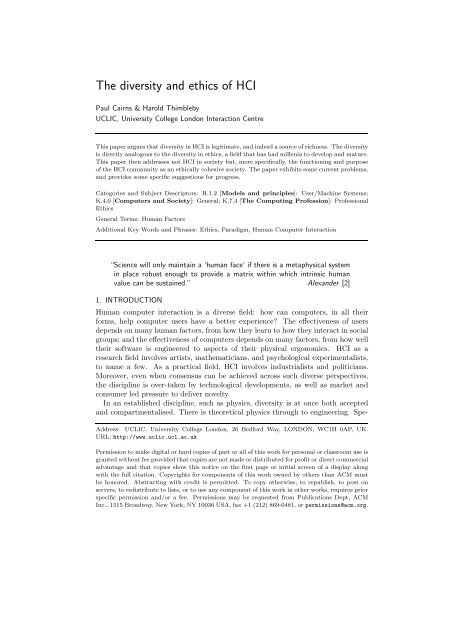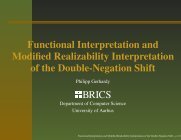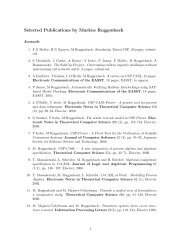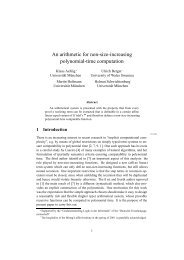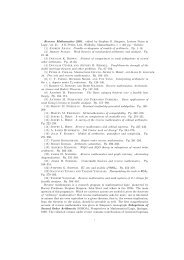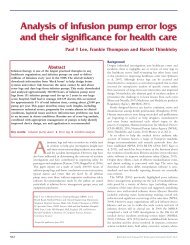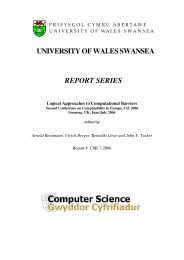The diversity and ethics of HCI - CiteSeerX
The diversity and ethics of HCI - CiteSeerX
The diversity and ethics of HCI - CiteSeerX
Create successful ePaper yourself
Turn your PDF publications into a flip-book with our unique Google optimized e-Paper software.
<strong>The</strong> <strong>diversity</strong> <strong>and</strong> <strong>ethics</strong> <strong>of</strong> <strong>HCI</strong><br />
Paul Cairns & Harold Thimbleby<br />
UCLIC, University College London Interaction Centre<br />
This paper argues that <strong>diversity</strong> in <strong>HCI</strong> is legitimate, <strong>and</strong> indeed a source <strong>of</strong> richness. <strong>The</strong> <strong>diversity</strong><br />
is directly analogous to the <strong>diversity</strong> in <strong>ethics</strong>, a field that has had millenia to develop <strong>and</strong> mature.<br />
This paper then addresses not <strong>HCI</strong> in society but, more specifically, the functioning <strong>and</strong> purpose<br />
<strong>of</strong> the <strong>HCI</strong> community as an ethically cohesive society. <strong>The</strong> paper exhibits some current problems,<br />
<strong>and</strong> provides some specific suggestions for progress.<br />
Categories <strong>and</strong> Subject Descriptors: H.1.2 [Models <strong>and</strong> principles]: User/Machine Systems;<br />
K.4.0 [Computers <strong>and</strong> Society]: General; K.7.4 [<strong>The</strong> Computing Pr<strong>of</strong>ession]: Pr<strong>of</strong>essional<br />
Ethics<br />
General Terms: Human Factors<br />
Additional Key Words <strong>and</strong> Phrases: Ethics, Paradigm, Human Computer Interaction<br />
“Science will only maintain a ‘human face’ if there is a metaphysical system<br />
in place robust enough to provide a matrix within which intrinsic human<br />
value can be sustained.” Alex<strong>and</strong>er [2]<br />
1. INTRODUCTION<br />
Human computer interaction is a diverse field: how can computers, in all their<br />
forms, help computer users have a better experience? <strong>The</strong> effectiveness <strong>of</strong> users<br />
depends on many human factors, from how they learn to how they interact in social<br />
groups; <strong>and</strong> the effectiveness <strong>of</strong> computers depends on many factors, from how well<br />
their s<strong>of</strong>tware is engineered to aspects <strong>of</strong> their physical ergonomics.<strong>HCI</strong> as a<br />
research field involves artists, mathematicians, <strong>and</strong> psychological experimentalists,<br />
to name a few.As a practical field, <strong>HCI</strong> involves industrialists <strong>and</strong> politicians.<br />
Moreover, even when consensus can be achieved across such diverse perspectives,<br />
the discipline is over-taken by technological developments, as well as market <strong>and</strong><br />
consumer led pressure to deliver novelty.<br />
In an established discipline, such as physics, <strong>diversity</strong> is at once both accepted<br />
<strong>and</strong> compartmentalised.<strong>The</strong>re is theoretical physics through to engineering.Spe-<br />
Address: UCLIC, University College London, 26 Bedford Way, LONDON, WC1H 0AP, UK.<br />
URL: http://www.uclic.ucl.ac.uk<br />
Permission to make digital or hard copies <strong>of</strong> part or all <strong>of</strong> this work for personal or classroom use is<br />
granted without fee provided that copies are not made or distributed for pr<strong>of</strong>it or direct commercial<br />
advantage <strong>and</strong> that copies show this notice on the first page or initial screen <strong>of</strong> a display along<br />
with the full citation. Copyrights for components <strong>of</strong> this work owned by others than ACM must<br />
be honored. Abstracting with credit is permitted. To copy otherwise, to republish, to post on<br />
servers, to redistribute to lists, or to use any component <strong>of</strong> this work in other works, requires prior<br />
specific permission <strong>and</strong>/or a fee. Permissions may be requested from Publications Dept, ACM<br />
Inc., 1515 Broadway, New York, NY 10036 USA, fax +1 (212) 869-0481, or permissions@acm.org.
2 · P. Cairns & H. Thimbleby<br />
cialist subareas, such as electronics, are further divided into power, analog, digital,<br />
microwave <strong>and</strong> so on.Workers in an area <strong>of</strong> physics draw upon the knowledge <strong>and</strong><br />
practice <strong>of</strong> that particular area.In <strong>HCI</strong>, there is no such privilege — one aspect <strong>of</strong><br />
usability cannot be neglected at the expense <strong>of</strong> another even, as we shall discuss,<br />
when conducting research.<strong>The</strong> resulting tension makes it difficult to progress the<br />
discipline in a scientific manner <strong>and</strong>, indeed, some <strong>HCI</strong> practioners are deliberately<br />
moving away from science <strong>and</strong> re-br<strong>and</strong>ing the subject as interaction design [32].<br />
This paper discusses the source <strong>of</strong> tension <strong>and</strong> even confusion over what <strong>HCI</strong> is.<br />
We attribute the tension to a lack <strong>of</strong> working paradigm, to use Kuhn’s term [17].<br />
Furthermore, we contend that not only does <strong>HCI</strong> not currently have an appropriate<br />
paradigm, it will not have any paradigm in the foreseeable future.In Kuhn’s<br />
view, this suggests that <strong>HCI</strong> cannot function as a science.We are not however<br />
claiming that <strong>HCI</strong> could or should function as a science like physics.Instead, in<br />
our discussion, paradigms are to be understood in the broader sense <strong>of</strong> the manner<br />
in which subjects organise themselves <strong>and</strong> function.Even in this broad sense, a<br />
useful <strong>HCI</strong> paradigm is elusive because <strong>of</strong> the lack <strong>of</strong> stable phenomena <strong>of</strong> study.<br />
However, <strong>HCI</strong> does have a more established epistemolgical heritage, namely in<br />
the field <strong>of</strong> <strong>ethics</strong>.This provides the intellectual rigour <strong>and</strong> tradition to replace the<br />
narrow conception <strong>of</strong> needing ‘a’ paradigm.<strong>The</strong> long-accepted <strong>diversity</strong> in <strong>ethics</strong><br />
corresponds, as indeed it must, to <strong>diversity</strong> in the field <strong>of</strong> <strong>HCI</strong>.<br />
2. ETHICS<br />
Ethics is <strong>of</strong>ten taken as a narrow pr<strong>of</strong>essional <strong>ethics</strong>: in <strong>HCI</strong>, this would mean,<br />
for example, not exploiting users or taking due care when working with children.<br />
Most pr<strong>of</strong>essional societies have codes <strong>of</strong> <strong>ethics</strong>; the ACM has one [1], <strong>and</strong> <strong>HCI</strong><br />
practitioners who are members <strong>of</strong> the ACM special interest group in <strong>HCI</strong> (ACM<br />
SIGCHI) effectively submit to this code.<strong>The</strong> simple motivation for pr<strong>of</strong>essional<br />
<strong>ethics</strong> is that it provides a generic framework to define ‘best practice’ that limits<br />
legal liability.<br />
Burmeister [5] interprets the Australian Computer Society’s code <strong>of</strong> <strong>ethics</strong> for<br />
usability engineers.His examples raise questions about how to respond to problems;<br />
for example, in a usability study <strong>of</strong> a web browser, a subject accidentally finds an<br />
objectionable web site — what do you do within the code <strong>of</strong> <strong>ethics</strong>? In contrast,<br />
in this paper we want to take <strong>ethics</strong> as a guide for positive action, not as a guide<br />
just for managing exceptions.As we shall see, this perspective itself mirrors one <strong>of</strong><br />
our arguments about usability: is usability about removing problems, or is it about<br />
pursuing good?<br />
<strong>HCI</strong> can be involved in the design <strong>of</strong> interactive systems that unequivocally raise<br />
ethical issues.For example, how should the user interface <strong>of</strong> a euthanasia assistant<br />
be designed? Should it have undo? Should it require more than one user? Somehow<br />
the rules written into the program that implements the assistant become moral rules<br />
imposed on (or unavoidable by) the users <strong>of</strong> the device; or, conversely, the moral<br />
dilemmas raised by the use <strong>of</strong> the device are either anticipated or ignored in the<br />
coding <strong>of</strong> the s<strong>of</strong>tware.<br />
Less obvious are the <strong>ethics</strong> <strong>of</strong> devices like mobile phones.<strong>The</strong> code inside a mobile<br />
phone imposes a way <strong>of</strong> use onto users, <strong>and</strong> for example influences how individuals<br />
can communicate using the short message service.Can errors be undone? <strong>The</strong>
Diversity <strong>and</strong> <strong>ethics</strong> <strong>of</strong> <strong>HCI</strong> · 3<br />
Ethics<br />
Deontology<br />
Situation <strong>ethics</strong> (ethical particularlism)<br />
Ethical monism<br />
Utilitarianism<br />
Consequentialism<br />
Virtue <strong>ethics</strong><br />
Hedonism<br />
<strong>HCI</strong><br />
St<strong>and</strong>ards (e.g., ISO, NASA)<br />
Depends on user’s task, motivation, etc<br />
Usability<br />
Cost-effectiveness <strong>of</strong> design<br />
Usability metrics<br />
<strong>The</strong> designer is right<br />
Promote user enjoyment<br />
Fig. 1.<br />
Some example <strong>ethics</strong>/<strong>HCI</strong> correspondences.<br />
tediousness <strong>of</strong> writing clearly, which is a direct consequence <strong>of</strong> the user interface<br />
design, has led to the widespread adoption <strong>of</strong> shorth<strong>and</strong> languages.Examples like<br />
“CU L8R” are at once a sign <strong>of</strong> user creativity, a symbol <strong>of</strong> being in a trendy culture,<br />
<strong>and</strong> a consequence <strong>of</strong> inefficient design — or perhaps a successful outcome <strong>of</strong> shoehorning<br />
a bigger application into a physical device that might otherwise have been<br />
thought too small to support it.<br />
Being able to interpret <strong>HCI</strong> ethically is not so surprising.<strong>HCI</strong> is a normative<br />
science that aims to improve usability.<strong>The</strong> three conventional normative sciences<br />
are æsthetics, which deals with things that are admirable, <strong>ethics</strong>, which deals with<br />
things that are good, <strong>and</strong> logic which deals with things that are true [30].Broadly,<br />
<strong>HCI</strong>’s approaches can be separated into these categories: logic corresponds to formal<br />
methods in <strong>HCI</strong> <strong>and</strong> computer science issues; modern approaches, such as<br />
persuasive interfaces <strong>and</strong> emotional impact, are æsthetics; <strong>and</strong> the core body <strong>of</strong><br />
<strong>HCI</strong> corresponds with <strong>ethics</strong>.Some might add to this list rhetoric (using communication<br />
effectively), but, whatever terms we use, <strong>HCI</strong> is about making the user<br />
experience good.When considered further, the parallels between <strong>ethics</strong> <strong>and</strong> <strong>HCI</strong><br />
are substantial (see Figure 1).This, then, is no accident.It would be informative<br />
to explore the relationships deeper but this paper is not the place to review the<br />
vast subject <strong>of</strong> <strong>ethics</strong> per se! Instead we exemplify the value <strong>of</strong> ethical parallels<br />
in <strong>HCI</strong> by taking just three particular ethical stances <strong>and</strong> interpreting (some) <strong>HCI</strong><br />
work from these positions: Christian <strong>ethics</strong>, medical <strong>ethics</strong> <strong>and</strong> Rawlsian justice.<br />
Regardless <strong>of</strong> one’s commitment, indifference or opposition to these particular<br />
stances we have chosen to discuss, they provide coherent <strong>ethics</strong>.Of course there is<br />
yet more to the ethical implications that we do not have space to debate here, just<br />
as there is yet more to <strong>HCI</strong> itself: <strong>HCI</strong> for game playing, learning environments,<br />
persuasive applications (‘captology’ [12]) or secure systems (e.g., voting) highlight<br />
some further complementary ethical issues that are not explored here.<strong>The</strong> point is,<br />
for the purposes <strong>of</strong> this paper, that drawing out specific ethical relations with <strong>HCI</strong><br />
is both challenging <strong>and</strong> rewarding; using <strong>ethics</strong> constructively raises relevant <strong>and</strong><br />
perceptive issues in <strong>HCI</strong> — <strong>and</strong> ones that practitioners may make either implicit<br />
or explicit commitments to.Further, if practitioners make ethical commitments to<br />
an established framework, debate about that choice becomes routine.<br />
2.1 Christian <strong>ethics</strong><br />
<strong>HCI</strong> has a set <strong>of</strong> basic assumptions.We should empower users.But why? Why<br />
not exploit users <strong>and</strong> maximise corporate pr<strong>of</strong>it? We should improve usability.But
4 · P. Cairns & H. Thimbleby<br />
why? Why not encourage users to buy upgrades, <strong>and</strong> encourage market churn?<br />
Users make mistakes, so user interfaces should have undo.But why not make users<br />
live with their mistakes?<br />
Clearly, <strong>HCI</strong> — or a different <strong>HCI</strong> — could work from a different set <strong>of</strong> assumptions.<br />
Christianity takes a set <strong>of</strong> assumptions from the Bible.Humans are diverse <strong>and</strong><br />
made in the image <strong>of</strong> God; because people are valuable, it is worth striving to<br />
improve their circumstances; but creation is fallen, through the agency <strong>of</strong> sin, <strong>and</strong><br />
attempts to improve situations are likely to fail unpredictably.Christians deal with<br />
this by promoting grace <strong>and</strong> forgiveness.And so on ...(this paper is not the place<br />
to pursue any particular framework in depth; the technical Christian terms can be<br />
followed up in [16]).<br />
Compare these ethical positions with those <strong>of</strong> <strong>HCI</strong>.<strong>The</strong> basic assumptions <strong>of</strong><br />
<strong>HCI</strong> are that users are diverse <strong>and</strong> valuable.It is worth developing new systems<br />
that improve users’ circumstances.However, the world is complex <strong>and</strong> designers<br />
build systems for them that then fail in unexpected ways.<strong>The</strong>se shortcomings can<br />
be ameliorated by things like better user training, or better error recovery — but<br />
these may also fail in interesting ways.Iterative design is recognition <strong>of</strong> the fallen<br />
nature <strong>of</strong> systems.That is, the current system is not as it should be: as good <strong>HCI</strong><br />
practitioners, we should continually strive to improve it.<br />
Christianity <strong>and</strong> science do not currently sit comfortably together.Historically,<br />
however, the Western development <strong>of</strong> science (which contrasts with Chinese <strong>and</strong><br />
Arabic developments, <strong>and</strong> indeed with developments under any other worldview)<br />
was motivated by the monotheistic imperative that nature has a structure <strong>and</strong><br />
purpose.Even Einstein, who did not believe in a personal God, held that “God<br />
does not play dice” [11]. Many <strong>of</strong> today’s ethical dilemmas (e.g., euthanasia, abortion,<br />
cloning, genetic modification, industrial pollution) arise because <strong>of</strong> an <strong>of</strong>ten<br />
unspoken tension between ‘raw’ technical developments <strong>and</strong> implicit Christian ethical<br />
habits <strong>of</strong> thought.Being clear that the <strong>HCI</strong> ethical orientation emerges from<br />
the Western/Christian matrix highlights responsibilities — a Christian might put<br />
it thus: good <strong>HCI</strong> is not optional because users are sacred.<strong>The</strong> answer to the<br />
lawyer’s famous question to Jesus [22] is, “the user is your neighbour.”<br />
2.2 Medical <strong>ethics</strong><br />
Medicine shares a lot with <strong>HCI</strong> [40].People have medical problems <strong>and</strong> doctors<br />
want to fix those problems.<strong>The</strong>re is a whole range <strong>of</strong> medical approaches.Physiotherapy<br />
trains people to cope better — like <strong>HCI</strong>’s emphasis on training.<strong>The</strong>re is<br />
corrective surgery that like <strong>HCI</strong> might do “hip replacements” to change one system<br />
for a better one.<strong>The</strong>re is preventive medicine, health, fitness, forensic, pharmaceutics<br />
<strong>and</strong> other branches.Both medicine <strong>and</strong> <strong>HCI</strong> are trying to improve people’s<br />
lives <strong>and</strong> both have the knowledge <strong>and</strong> power to do so.If you invent a drug to combat<br />
a disease you transform the world; if you develop a user interface (particularly<br />
a web-delivered one) you transform the world.<br />
Medicine has been around a lot longer than <strong>HCI</strong>, yet it has survived in a recognisable<br />
form since the Hippocratic Oath was created.Indeed, the Oath constitutes<br />
an ethical stance on what medicine is <strong>and</strong> how it should be practiced.<strong>The</strong> Oath,<br />
although now obsolete, brought coherence to the discipline in terms <strong>of</strong> what is <strong>and</strong>
Diversity <strong>and</strong> <strong>ethics</strong> <strong>of</strong> <strong>HCI</strong> · 5<br />
is not acceptable practice.Though medicine has changed radically over the millenia<br />
<strong>and</strong> new technology (the same technology driving <strong>HCI</strong>) is changing it at an<br />
ever-increasing rate, there are clear <strong>and</strong> exacting procedures that must be followed<br />
if you are claiming to do medical research.New drugs are only introduced after a<br />
long, staged series <strong>of</strong> trials; trials must be <strong>of</strong> a certain size <strong>and</strong> controlled; reports<br />
<strong>of</strong> results must allow other clinicians to repeat the work.Different countries have<br />
different rules.And so on ...<br />
With Christian <strong>ethics</strong> we illustrated an implicit connection that does not not<br />
necessarily determine detailed procedures (e.g., controls or r<strong>and</strong>omised trials); but<br />
with medical <strong>ethics</strong> we illustrated a more prescriptive ethical framework, which if<br />
taken seriously would challenge <strong>HCI</strong>’s de facto ethical st<strong>and</strong>ards.<strong>HCI</strong> would do<br />
well to learn from the processes that medical <strong>ethics</strong> requires.When we develop new<br />
web technologies, affecting millions <strong>of</strong> people, are the experiments done carefully,<br />
or with half a dozen students? Do we only do experiments on our own familiar<br />
systems? Are we satisfied announcing results with only three out <strong>of</strong> five patients<br />
cured? Do we use placebos, double blinds, controls? Did our published output<br />
provide enough details or enough <strong>of</strong> a working system for other people to check the<br />
results?<br />
At the very least, <strong>HCI</strong> researchers should work to basic clinical st<strong>and</strong>ards when we<br />
do get to help design medical systems.If further we are to improve <strong>HCI</strong> more widely,<br />
one <strong>of</strong> the places to start is in our procedures for publishing <strong>and</strong> disseminating best<br />
practice.In medicine, any reliable knowledge is worth building on; in <strong>HCI</strong> practice<br />
we are more <strong>of</strong>ten concerned with the excitement <strong>and</strong> business side <strong>of</strong> things than<br />
the quality <strong>of</strong> the science <strong>and</strong> the <strong>ethics</strong> <strong>of</strong> doing it.<br />
Thus, the medical ethical stance has a lot <strong>of</strong> mileage when adopted in <strong>HCI</strong>.After<br />
all, both fields are improving people’s lives, but medicine has been doing it longer,<br />
so we surely have much to learn from it.<br />
2.3 Rawlsian justice<br />
A st<strong>and</strong>ard problem in <strong>ethics</strong> is to operationalise it; how <strong>and</strong> under what conditions<br />
do you do good? Rawls provides a thought experiment in the specific area <strong>of</strong> justice<br />
[34].Rawls imagined a political world with rules.In what sense can this world be<br />
just, <strong>and</strong> if so, how can the rules be defined?<br />
First, note the analogy with <strong>HCI</strong>.In <strong>HCI</strong> we are concerned with creating ‘worlds’<br />
for users that are just.A device like a mobile phone, say, imposes a set <strong>of</strong> rules<br />
<strong>of</strong> interaction on the people who use it.In some sense the <strong>HCI</strong> designer wishes to<br />
bring about a world in which justice is increased.Rawls, <strong>of</strong> course, considered this<br />
problem in the political domain, as in how would a society be brought about where<br />
there is an increase in justice.<br />
A key problem is that politicians are selfish, <strong>and</strong> unlikely to define just laws.<br />
Rawls’s solution was to envisage a veil <strong>of</strong> ignorance.Politicians would design the<br />
society in ignorance <strong>of</strong> what future role they would play in that society.Only if<br />
a politician did not know whether they would be rich or poor, single or married,<br />
disabled, young, isolated ... would they devise just laws.<br />
In <strong>HCI</strong>, we do not know what sort <strong>of</strong> users our systems will have.One <strong>of</strong> the<br />
st<strong>and</strong>ard slogans in <strong>HCI</strong> is that, unless designers consciously do otherwise, systems<br />
are accidentally built for their designers, not for their users.In a sense, unless
6 · P. Cairns & H. Thimbleby<br />
designers consciously work under a Rawlsian veil <strong>of</strong> ignorance, they are susceptible<br />
to building systems they like, rather than systems that benefit their users.<br />
If a designer considered that, in the world where their system is imposed, they<br />
might be working on a user support line, or they might be writing the system’s<br />
user manuals, or they might be actual users — then they would design with more<br />
consideration.In fact, for any successful system, designers are more likely to be<br />
ordinary users than any other category <strong>of</strong> user.Steve Job’s famous exhortation to<br />
reduce the boot time <strong>of</strong> early Macintosh computers is a case <strong>of</strong> this insight : every<br />
second a Mac takes to boot, there are so many users waiting, that cummulatively<br />
whole lives are being wasted.On Rawls’ account, developing user interfaces to<br />
make weapons <strong>of</strong> mass destruction easier to use would be unjust, since no designer<br />
would wish live in the target population.<br />
<strong>The</strong> two contrasting examples, Mac user interfaces <strong>and</strong> weapons interfaces, shows<br />
how a Rawlsian view <strong>of</strong> justice leads to <strong>HCI</strong> pr<strong>of</strong>essionals probing <strong>and</strong> then making<br />
ethical decisions that influence their activities.Further discussion <strong>and</strong> a worked<br />
example in <strong>HCI</strong> can be found in [10].<br />
2.4 Summary<br />
To summarise, the three ethical stances addressed here give concrete <strong>and</strong> useful<br />
insights into <strong>HCI</strong> practice.Christian <strong>ethics</strong> already has a strong influence on current<br />
<strong>HCI</strong> values; medical <strong>ethics</strong> has similarities but more exacting st<strong>and</strong>ards; <strong>and</strong><br />
Rawlsian justice is already partially, albeit implicitly, employed as a design maxim.<br />
Even if <strong>HCI</strong> did not require an ethical meta-perspective, explicitly describing <strong>and</strong><br />
developing <strong>HCI</strong> via these stances would bring new <strong>and</strong> good practices to <strong>HCI</strong>.However,<br />
as the next section discusses, <strong>HCI</strong> requires a meta-framework where values<br />
can be debated because it is incapable <strong>of</strong> having the inherent structure <strong>of</strong> a normal<br />
science.<br />
3. <strong>HCI</strong> EXPANSION<br />
Computers are now pervasive, <strong>and</strong> new <strong>and</strong> innovative uses are being found daily.<br />
<strong>HCI</strong> has changed <strong>and</strong> adapted from its early beginnings in microcomputers <strong>and</strong> the<br />
organisational issues <strong>of</strong> the 1960s timeshared computer systems to the personal <strong>and</strong><br />
international internet needs <strong>of</strong> the 2000s: a vast change, both smaller <strong>and</strong> bigger.<br />
<strong>HCI</strong> is now one <strong>of</strong> the most rapidly growing areas in computer science [35].In such<br />
a flourishing environment, it is surprising that <strong>HCI</strong> is not gaining strength <strong>and</strong><br />
momentum.Instead, it seems fraught with re-br<strong>and</strong>ing as interaction design [32],<br />
new usability [44] or funology [23].<strong>The</strong>se changes <strong>of</strong> nomenclature reflect deeper<br />
disagreements as to what <strong>HCI</strong> is, disagreements reflected in the apparent absurdity<br />
<strong>of</strong> reviews <strong>of</strong> papers <strong>and</strong> research proposals.<strong>The</strong> authors <strong>of</strong> this paper have had different<br />
referees say <strong>of</strong> the same work that it is internationally outst<strong>and</strong>ing research,<br />
<strong>and</strong> not worth an undergraduate diploma. 1 In essence though, it seems that these<br />
features in <strong>HCI</strong> are symptomatic <strong>of</strong> a single cause: <strong>HCI</strong> does not have a paradigm<br />
1 Note: we are not just authors; we are also referees ourselves, <strong>and</strong> we admit “from the other side<br />
<strong>of</strong> the fence” that it is extremely difficult to referee <strong>HCI</strong> (<strong>and</strong> <strong>HCI</strong>-related topics) fairly. That is,<br />
we are not complaining about referees, as if authors are right <strong>and</strong> referees wrong; we are referees<br />
too. Both authors <strong>and</strong> referees are part <strong>of</strong> the same community.
Diversity <strong>and</strong> <strong>ethics</strong> <strong>of</strong> <strong>HCI</strong> · 7<br />
[17].Some evidence for this is laid out below.Straightforward analysis shows that<br />
the reason for the lack <strong>of</strong> paradigm can be simply attributed to consequences <strong>of</strong><br />
Moore’s Law [24].This has deeper implications: not only does <strong>HCI</strong> not currently<br />
have a paradigm, but that whilst Moore’s Law holds it will be impossible for <strong>HCI</strong><br />
to have a paradigm.<br />
3.1 Paradigm Lost<br />
Paradigm is a now well-established term in the philosophy <strong>of</strong> science as a result<br />
<strong>of</strong> the work <strong>of</strong> Kuhn [17] <strong>and</strong> is broadly adopted as a tool for investigating social<br />
phemonena, too.(For example, the impact on business <strong>of</strong> ‘disruptive technologies’<br />
[9] is analogous to Kuhn’s crises.) According to Kuhn, when an area <strong>of</strong> science<br />
has a paradigm, there is some fundamental set <strong>of</strong> assumptions agreed upon by that<br />
particular scientific community.<strong>The</strong> full extent <strong>of</strong> these assumptions are rarely<br />
made explicit but allow the science to proceed “normally.” That is, the paradigm<br />
has some descriptive <strong>and</strong> explanatory power, <strong>and</strong> normal scientific research works<br />
to extend the paradigm to cover previously unexplained phenomena.Furthermore,<br />
the questions asked whilst doing normal science are usually obviously answerable,<br />
at least in principle, in terms <strong>of</strong> the paradigm — Kuhn saw normal science as<br />
routine puzzle solving.<strong>The</strong> novelty <strong>of</strong> the research exists in working out details.<br />
As Kuhn describes it, there is usually a particular paradigm embodied in a theory<br />
used to conduct research in the area.Kuhn’s historical perspective <strong>of</strong> how science<br />
progresses is not universally accepted (e.g., it contrasts with a Popperian account<br />
[13]), but paradigms remain a central <strong>and</strong> perceptive concept for describing <strong>and</strong><br />
distinguishing normal, incremental <strong>and</strong> coherent scientific research by a community<br />
<strong>of</strong> people.<br />
It is easy to point to theories in <strong>HCI</strong> that have enjoyed success: GOMS [6];<br />
affordances [25]; situated actions [37], say.Like paradigmatic theories, to a degree,<br />
they underlie a lot <strong>of</strong> current practice in <strong>HCI</strong>.However, a scan <strong>of</strong> important <strong>HCI</strong><br />
journals shows that there seems to be little normal science being done to extend<br />
or refine these ideas to new phenomena.Indeed, Norman is even rebuking <strong>HCI</strong> for<br />
the misuse <strong>of</strong> the term ‘affordance’ to describe certain interactions [26].So, though<br />
these are relevant <strong>and</strong> valid theories, they lack the power <strong>and</strong> focus <strong>of</strong> paradigms<br />
to aid a coherent research effort.<br />
Although it helps to give specific examples, the flaws <strong>and</strong> strengths <strong>of</strong> any individual<br />
theory (such as those mentioned above) are not relevant here.Nonetheless,<br />
leading researchers in <strong>HCI</strong> declare themselves to be still looking for theories <strong>of</strong> <strong>HCI</strong>.<br />
Shneiderman has said that he is “... looking for a generative theory <strong>of</strong> <strong>HCI</strong>” [Personal<br />
communication], Peter Johnson is “trying to produce a theoretical framework<br />
for interaction.As are we all.” [Personal communication] <strong>and</strong> even we want “a way<br />
to analyse [user interface] designs before they are built” [42].<br />
<strong>The</strong> consequences <strong>of</strong> an absence <strong>of</strong> theory are also evident.Kuhn describes some<br />
features <strong>of</strong> a ‘pre-paradigm’ or ‘between-paradigm’ science:<br />
—Squabbles over what are legitimate tools for research<br />
—Squabbles over what are legitimate phenomena to study<br />
—Inability to scope the domain <strong>of</strong> study<br />
Evidence for some <strong>of</strong> these features can be found in Höök’s discussion list in CHI
8 · P. Cairns & H. Thimbleby<br />
Place [15], the purpose <strong>of</strong> which was simply as a forum for discussing the referees’<br />
comments on recent CHI 2003 submissions.In particular the thread initiator<br />
asked for referees’ comments that seemed particularly irrelevant or ludicrous.Assuming<br />
that <strong>HCI</strong> is not filled with mischievous or incompetent referees, ludicrous<br />
or irrelevant reviews could only come from the inability to communicate.That<br />
failure must also be in both directions unless <strong>HCI</strong> has an unusually large number<br />
<strong>of</strong> mischievous or incompetent authors failing to underst<strong>and</strong> reviewers.A plausible<br />
argument for this failure to communicate would be an absence <strong>of</strong> shared knowledge<br />
<strong>and</strong> framework in which to argue.Or to put it another way, a lack <strong>of</strong> common<br />
paradigm.<br />
A more surprising contribution to Höök’s list was from Jonathan Grudin.As an<br />
editor <strong>of</strong> this journal, as well as a researcher <strong>of</strong> some experience <strong>and</strong> st<strong>and</strong>ing, he<br />
surely knows what constitutes a good <strong>HCI</strong> article.However, he too bemoaned that<br />
he had recently had rejected his “best CHI submission in a decade.” This may be a<br />
common occurrence in <strong>HCI</strong> but in mathematics, say, it would be unthinkable that<br />
a significant researcher (not yet in their dotage) would be rejected at a conference.<br />
This is not because mathematicians always produce publishable research but rather<br />
because any researcher <strong>of</strong> sufficient experience <strong>and</strong> maturity would only <strong>of</strong>fer good<br />
things for publication.And if they were mistaken <strong>and</strong> their research was flawed<br />
they certainly would not get in a position <strong>of</strong> lamenting unfair treatment.Grudin’s<br />
case, then, seems again to be an instance <strong>of</strong> referees <strong>and</strong> authors failing to engage<br />
on a common theoretical basis even when the author has good authority for the<br />
validity <strong>of</strong> his research.<br />
As Kuhn points out though, the absence <strong>of</strong> paradigm need not be a cause for<br />
concern.It is a legitimate, recognisable phase in the growth or emergence <strong>of</strong> any<br />
science.Through argument over legitimate objects <strong>and</strong> tools <strong>of</strong> study, new theories<br />
emerge with greater explicative <strong>and</strong> predictive power.Comments from a number<br />
<strong>of</strong> contributors to Chalmers’s list [8] indicate that they are expecting a theory or<br />
theories to emerge.We argue that this is unlikely to happen in the near future.<br />
3.2 Phenomenology in <strong>HCI</strong><br />
In the natural sciences, any theory is aiming to describe a set <strong>of</strong> phenomena.Quite<br />
which phenomena are targeted by any particular theory tends to be built into a<br />
paradigm rather than chosen on a more logical basis.Gravity, the mutual attraction<br />
<strong>of</strong> all massive bodies, was not studied as a phenomenon until Newton described it.<br />
Once a particular phenomenon has been observed <strong>and</strong> recognised as important, successive<br />
theories must either explain it or incorporate it into the theory.For example,<br />
when faced with the problem <strong>of</strong> the constancy <strong>of</strong> the speed <strong>of</strong> light in Newtonian<br />
mechanics, any new theory would have to predict the constancy or build in the<br />
constancy <strong>of</strong> the speed <strong>of</strong> light, as did special relativity [11].Once there is a theory,<br />
new ideas are highlighted that nobody was aware <strong>of</strong> prior to the formulation <strong>of</strong> the<br />
theory; indeed, coincidences or anomalies that may not previously have been noticed<br />
— or, indeed, that people refused to notice because there was ‘no’ compelling<br />
explanation — may now be explained in the terms <strong>of</strong> the theory [20].In <strong>HCI</strong> we<br />
do not have the conceptual structures provided by compelling explanations; there<br />
are few if any anomalies begging for explanation.Often problems are trivialised<br />
because the theory is deemed inapplicable in the troublesome area — none <strong>of</strong> the
Diversity <strong>and</strong> <strong>ethics</strong> <strong>of</strong> <strong>HCI</strong> · 9<br />
theories available to <strong>HCI</strong> claim to have the generality <strong>and</strong> precision <strong>of</strong>, say, gravity<br />
that affects all bodies in the same way.<br />
Furthermore in <strong>HCI</strong>, the phenomena <strong>of</strong> study are much less enduring, simply<br />
because they arise as a result <strong>of</strong> interaction with an artefact.Artefacts are not<br />
externally given but can be modified by their makers.Thus the phenomena <strong>of</strong><br />
<strong>HCI</strong> are not givens.For instance, a theory may explain the reasons why paragraph<br />
formatting is difficult in a particular word processing package, only to find that the<br />
next version does not use the same method <strong>and</strong> the whole problem has gone away.<br />
And even if this did not happen, another argument might be to say, “Well, if that<br />
package is problematic, use this one instead.”<br />
Of course, if the artefacts <strong>of</strong> study <strong>of</strong> <strong>HCI</strong> were essentially static, such phenomena<br />
may vary between packages but a particular theory <strong>of</strong> say, how people interact with<br />
word processors, could eventually be possible <strong>and</strong> proscribe <strong>and</strong> prescribe particular<br />
interactions (or whatever).In reality, <strong>of</strong> course, <strong>HCI</strong>’s artefacts are far from static.<br />
It is worth pressing this comparision further.In biology, we recognised a huge<br />
<strong>diversity</strong> <strong>of</strong> life. Its classification is a research field in its own right (e.g., phylogenetic<br />
systematics), <strong>and</strong> is one paradigmatically recognised as worthwhile.It is fair to say<br />
that the <strong>diversity</strong> <strong>of</strong> <strong>HCI</strong> artefacts is much less than the <strong>diversity</strong> <strong>of</strong> life, yet a<br />
cladistics <strong>of</strong> <strong>HCI</strong> would be pointless: there is no sense in principle that it could be<br />
completed, <strong>and</strong> none that a completed classification, even if it were possible, would<br />
be <strong>of</strong> value the following year.<br />
Although first put forward in 1965 <strong>and</strong> anticipating phenomenal growth in microelectronics,<br />
Moore’s Law is now taken to describe <strong>and</strong> predict a doubling <strong>of</strong><br />
computing power (e.g., calculations per second) every eighteen months. Thus, at<br />
a purely algorithmic level [14], computers now can do about 100 times as many<br />
calculations per second as computers ten years ago.Moreover, that statement will<br />
still be true in ten years time.Many people, however, predict that soon Moore’s<br />
law will hit the physical limits <strong>of</strong> silicon <strong>and</strong> so will no longer hold.Brown <strong>and</strong><br />
Duguid argue that Moore’s Law is not a physical law but an economic one [4] —<br />
more akin to a measure <strong>of</strong> competition <strong>and</strong> success in chip manufacture than ability<br />
to manipulate materials.Thus, Moore’s Law is likely to hold for the foreseeable<br />
future.<br />
In terms <strong>of</strong> <strong>HCI</strong>, Moore’s Law may seem to have little bearing.After all, humans<br />
are not changing at an exponentially increasing rate <strong>and</strong> Moore’s Law only relates to<br />
raw computing power.Consider then Moore’s Law as interpreted in terms <strong>of</strong> screen<br />
images.It means that for the same size visual display, a computer can do 100 times<br />
more work to generate a single image than ten years ago.This makes possible<br />
virtual environments, gaming styles <strong>and</strong> visualisations that were not conceivable<br />
without that scaling up <strong>of</strong> power.Accordingly, the richness <strong>of</strong> potential human<br />
computer interaction is also scaled up.<br />
Visual display is only one area <strong>of</strong> interaction that could be potentially improved<br />
by Moore’s Law, but it demonstrates its implications.In parallel with Moore’s law,<br />
there have been astonishing reductions in the cost <strong>of</strong> memory chips, huge increases<br />
in the capactities <strong>of</strong> hard disks, massive reduction in power usage <strong>and</strong> screen displays,<br />
enormous increases in network connectivity.All these things have acted to<br />
move computers away from a traditional Turing machine model <strong>of</strong> computation to<br />
more dynamic, interactive computation [45] where computers <strong>and</strong> humans all act
10 · P. Cairns & H. Thimbleby<br />
as a collaborating network <strong>of</strong> agents.In practical terms, legitimate interest <strong>of</strong> <strong>HCI</strong><br />
in areas <strong>of</strong> ubiquitous computing, pervasive computing, implants <strong>and</strong> so on is now<br />
feasible — <strong>and</strong> challenging.Because <strong>of</strong> the rate <strong>of</strong> innovation, users have become<br />
informal <strong>HCI</strong> experts — exercising significant <strong>HCI</strong> preferences in their consumer<br />
choices, in turn driving new development; conversely, <strong>HCI</strong> pr<strong>of</strong>essionals have become<br />
users.(Contrast this accepted, almost unavoidable position, in <strong>HCI</strong> with the<br />
dem<strong>and</strong>s <strong>of</strong> medical research <strong>ethics</strong>.)<br />
In trying to produce a paradigm or core theory <strong>of</strong> <strong>HCI</strong>, researchers need to define<br />
<strong>and</strong> scope <strong>HCI</strong> phenomenologically.Or rather, producing a paradigm will entail an<br />
appropriate set <strong>of</strong> phenomena for <strong>HCI</strong> to study.But whilst Moore’s Law <strong>and</strong> its<br />
counterparts in networks, storage media <strong>and</strong> miniaturisation continue to hold, any<br />
circumscribed set <strong>of</strong> reified phenomena will be rapidly swamped in the exponentially<br />
exp<strong>and</strong>ing potential <strong>of</strong> computing power.Even if a phenomenology for interaction<br />
once existed, it certainly does not now.<strong>The</strong> implication for a paradigm or theory<br />
is that not only is there currently no paradigm but, in the persistent increase in<br />
available computational power, there can be no adequate paradigm.<br />
4. EXPELLED FROM PARADIGMS<br />
Without some meta-framework, such as that which a paradigm might have provided,<br />
we claim the expansion <strong>of</strong> <strong>HCI</strong> phenomena will always be too much for any<br />
individual to grasp.<strong>The</strong> result will be that <strong>HCI</strong> must become a loosely held community<br />
<strong>of</strong> “isl<strong>and</strong>s” where each isl<strong>and</strong> has its own acceptable basis for research but<br />
which has no easy communication with other isl<strong>and</strong>s.<br />
Without a paradigm, <strong>HCI</strong> cannot function as a normal science, in Kuhn’s sense.<br />
This is not alarming — there are many disciplines that make no claim to being<br />
natural sciences <strong>and</strong> yet which function perfectly well.<strong>HCI</strong> could perhaps borrow<br />
a framework from some <strong>of</strong> these other disciplines.<br />
<strong>The</strong> simplest <strong>of</strong> these would be to fall back <strong>and</strong> say that <strong>HCI</strong> is entirely a craft<br />
discipline.This has been explored extensively elsewhere [21] <strong>and</strong> it is not an appealing<br />
position, for then where is the science <strong>of</strong> any sort; where are the aspirations<br />
to truth? How can research be anything other than ad hoc?<br />
Design subjects, such as architecture or graphic design, have an obvious relevance<br />
to <strong>HCI</strong>.Yet, there is no more a theory <strong>of</strong> architecture than there is a theory <strong>of</strong><br />
<strong>HCI</strong>.This is not to say that design subjects are without a paradigmatic foundation.<br />
At the very least, in all but electronic media, there are concrete phenomenological<br />
constraints.Buildings are made from physical materials.Graphics are limited by<br />
the manufacture <strong>and</strong> reproduction quality.<br />
In addition, there is a persistence to non-virtual designs absent in computerbased<br />
designs.Architects in the sixties raved about the innovation in high-rise<br />
inner city developments <strong>and</strong> the opportunity for new types <strong>of</strong> communities.<strong>The</strong>y<br />
did not then immediately pull them down to build Version 2 <strong>of</strong> the same buildings.<br />
Instead, the buildings persisted, the communities grew into them <strong>and</strong> the grave<br />
flaws with the designs became apparent.And architects learned from them [19].<br />
This sort <strong>of</strong> learning from past designs is an essential part <strong>of</strong> any education in a<br />
design subject.<br />
Not only does <strong>HCI</strong> not have persistent phenomena, but analysis <strong>of</strong> existing designs,<br />
such as Paint Shop Pro or MS Word, are regarded as merely product reviews.
Diversity <strong>and</strong> <strong>ethics</strong> <strong>of</strong> <strong>HCI</strong> · 11<br />
This point <strong>of</strong> view is underst<strong>and</strong>able because, after all, no-one is going to have to<br />
worry about these designs in couple <strong>of</strong> years time.As a more substantial example,<br />
the Canon Cat is now regarded as an excellent piece <strong>of</strong> interaction design [33].<br />
Many older people hold it as the epitome <strong>of</strong> good design — <strong>and</strong> that computers<br />
have taken a lamentable down turn since then.But only older people.Young students<br />
doing <strong>HCI</strong> degrees now have never even seen a Cat (some weren’t even born<br />
when it was being produced!) <strong>and</strong> are never likely to do so either.<strong>The</strong>y cannot<br />
re-perceive the Cat for themselves <strong>and</strong> recontextualise it to novel designs.<strong>The</strong>y<br />
are reliant on (for instance) Raskin’s description <strong>of</strong> it <strong>and</strong> he can only tell them<br />
his own perceptions.<strong>The</strong> Cat can no longer be demonstrated widely (if in fact any<br />
working models <strong>of</strong> it still exist); <strong>and</strong> exhibitions or pictures <strong>of</strong> it do not capture or<br />
illustrate any <strong>HCI</strong> issues beyond its unexceptional physical form.<br />
Thus, to call <strong>HCI</strong> a design subject is attractive but misleading.<strong>HCI</strong> does not<br />
share a basic phenomonelogical reality with other design subjects.<strong>The</strong> community<br />
<strong>of</strong> <strong>HCI</strong> pr<strong>of</strong>essionals cannot build on each others’ work <strong>and</strong> a long-st<strong>and</strong>ing shared<br />
heritage <strong>of</strong> exemplars, about which ‘everybody’ has paradigmatic opinions.<br />
<strong>HCI</strong> could instead be regarded as a social science.Muller specifically makes<br />
this link in criticising the need for a theory by refering to the absence <strong>of</strong> theory<br />
in Woman’s Studies or African Studies [8].But once again, there are concrete<br />
phenomena underlying social sciences — people.Admittedly people are immensely<br />
complex in their social interactions but: they are not evolving (not, at least, at a<br />
rate significant with respect to the advacement <strong>of</strong> knowledge); individuals do not<br />
double their performance every eighteen months; societies can only really transform<br />
entirely on the scale <strong>of</strong> individual longevity.<br />
This may seem like an opening for <strong>HCI</strong> — it is really a social science about people<br />
<strong>and</strong> how they use computers.Social interaction is certainly a fascinating aspect <strong>of</strong><br />
<strong>HCI</strong> but if it were only that then we would be abdicating from trying to influence<br />
the computer side <strong>of</strong> the discipline.In effect, to view <strong>HCI</strong> as only social science is<br />
to fail the millions <strong>of</strong> users who suffer from poor interaction design everyday.<br />
4.1 Summary<br />
What this tells us is that <strong>HCI</strong>, like all disciplines, must carve its own framework in<br />
which to conduct research, develop skills <strong>and</strong> accumulate knowledge.<strong>The</strong> allure <strong>of</strong><br />
a natural science or social science or design subject framework is sadly superficial.<br />
However, by thinking about <strong>HCI</strong> as a normative <strong>and</strong> therefore as an ethical science,<br />
there is a possibility to adopt from <strong>ethics</strong> the appropriate framework for the study<br />
<strong>of</strong> good user interfaces.<br />
5. PRACTICAL SOLUTIONS<br />
We have already illustrated how particular ethical stances can help interpret <strong>and</strong><br />
stimulate work in <strong>HCI</strong>.Clearly in this paper, to explore all areas <strong>of</strong> <strong>HCI</strong> or <strong>ethics</strong><br />
<strong>and</strong> map out a full correspondence is surely to fall short <strong>of</strong> what is necessary.<br />
Instead, we draw out some practical solutions to problems in <strong>HCI</strong> as a discipline.<br />
<strong>The</strong>se are based on how <strong>ethics</strong>, as a discipline, is able to solve its own problems.
12 · P. Cairns & H. Thimbleby<br />
5.1 Privatives<br />
For any ethical position to influence, rather the merely comment on, behaviour,<br />
it needs to be operationalised like Rawlsian justice discussed earlier.If <strong>HCI</strong> is<br />
taken to be about making good user interfaces, what constitutes a good interface<br />
becomes very difficult to define.When “good” is not operationalised, it becomes<br />
very difficult to assess the value <strong>of</strong> work.<br />
As one concrete example (though there are potentially hundreds), in a classic <strong>HCI</strong><br />
paper, Young [47] describes how surrogates <strong>and</strong> task-action mappings make user<br />
interfaces more usable.In particular, Young provides a detailed critique <strong>of</strong> h<strong>and</strong>held<br />
calculators, <strong>and</strong> the user mapping their task into operations to comm<strong>and</strong> the<br />
calculator to achieve tasks.This analysis exposes some interesting design issues for<br />
calculators <strong>and</strong> similar styles <strong>of</strong> user interface, <strong>and</strong> contributes to the underst<strong>and</strong>ing<br />
<strong>of</strong> usability in such domains.One might think that the analysis therefore improves<br />
usability.If so it should be feasible to take an alternative domain, such as virtual<br />
reality or even a radically different calculator [39], <strong>and</strong> be able to apply the method.<br />
This turns out to be very problematic.In which case, the method competes with<br />
other conceptions <strong>of</strong> usability.For example, it is clear that task-action mappings<br />
ignore motivation, social context, error recovery <strong>and</strong> numerous other perspectives<br />
on usability.One might reasonably criticise task-action mapping as inadequate to<br />
achieve usability.<br />
As a move towards a form <strong>of</strong> usability that can be worked with (rather than one<br />
that encourages picking problems), we propose that usability is best thought <strong>of</strong> as<br />
a privative.<br />
Since Aristotle, a privative concept is a negative category <strong>of</strong> thought.In everyday<br />
English, a ‘privation’ is an absence <strong>of</strong> something wanted; the word privacy, for<br />
example, implies absence <strong>of</strong> public benefit.In many areas, the privative <strong>and</strong> positive<br />
are equivalent for practical reasoning.Another example: cold is the privative <strong>of</strong> the<br />
positive hot.We might draw curtains to keep out the cold, <strong>and</strong> this — as its very<br />
common usage suggests — makes sense.We put things in a fridge to cool them<br />
down.We put on jumpers so we don’t get cold.<br />
Is cold just the opposite <strong>of</strong> hot? Unfortunately, coldness is not quite the opposite<br />
<strong>of</strong> heat, for there are some cases where it does not work as naïve reasoning might<br />
lead one to think.For example, a heater with a parabolic reflector can heat an<br />
object at a distance; on the other h<strong>and</strong>, a ‘cooler’ with a parabolic reflector does<br />
not work.<strong>The</strong> reason is simple: heat is radiated from a hot object; even some<br />
heat is radiated from a cool object. Once there is a clear concept <strong>of</strong> energy (e.g.,<br />
electromagnetic radiation) it is clear that heat does work, <strong>and</strong> the idea <strong>of</strong> cold<br />
‘doing’ things is an informal, albeit convenient fiction.<br />
<strong>The</strong>re are many such historical examples <strong>of</strong> showing how science has progressed<br />
through privative concepts until appropriate theories ruled in favour <strong>of</strong> a positive<br />
version.Most famously, phlogiston was a very successful theory until precise measurement<br />
<strong>of</strong> mass <strong>and</strong> the discovery <strong>of</strong> oxygen suggested that phlogiston was better<br />
thought <strong>of</strong> as the private version <strong>of</strong> oxygen rather than treating it as the single<br />
negatively-massed element.Conversely, the discovery <strong>of</strong> electrons as charge carriers<br />
made no difference to Benjamin Franklin’s attribution <strong>of</strong> current flowing from<br />
positive to negative because we had no prior view that electricity had to be positive
Diversity <strong>and</strong> <strong>ethics</strong> <strong>of</strong> <strong>HCI</strong> · 13<br />
(as we do for mass).<br />
More recent examples <strong>of</strong> the value <strong>of</strong> privatives for explanation (so-called narrativium)<br />
can be found in the alternative science <strong>of</strong> Discworld, the popular fantasy<br />
milieu created by Terry Pratchett [31].Our analogy here is not purely made in<br />
jest! Pratchett creates an alternative world, much like <strong>HCI</strong> creates new worlds for<br />
users — indeed, worlds that envisioned only a few years ago would have seemed<br />
to be science fiction too.Pratchett argues that worlds are held together by their<br />
narrativium, the narrative sense they make to readers — or in <strong>HCI</strong>, the sense they<br />
make to users.<br />
Now to the point.Usability can be understood as a privative.Usability is the<br />
absence <strong>of</strong> usability problems.Problems are the positive concept, <strong>and</strong> problems<br />
are what designers <strong>and</strong> users have control <strong>of</strong>.To the extent that phlogiston, cold,<br />
<strong>and</strong> other privatives seem to make sense, there is some sense in ‘making’ systems<br />
usable.But this sense disappears when one tries to explain rigorously what in fact<br />
is happening.Narrowing usability to a less interactive more ergonomic sense, a<br />
system is usable if it is comfortable but in ergonomics, comfort has already been<br />
recognised as a privative concept [29].<br />
With usability viewed as a privative, Young [op cit] identified one way to analyse a<br />
failing in usability, namely that <strong>of</strong> awkward task-action mappings, though expressed<br />
in positive terms.Thus, Young’s method cannot be expected to improve usability<br />
universally — only to remove certain types <strong>of</strong> usability problems.<br />
Crucially, seen as a privative, it is now legitimate to have alternative ways <strong>of</strong><br />
critiquing usability.Motivation, for instance, which task-action mappings ignore, is<br />
no longer an omission <strong>of</strong> Young’s position, but now is an alternative complementary<br />
framework to highlight other sorts <strong>of</strong> usability problem.<br />
5.2 Complementarity<br />
<strong>The</strong> rich <strong>diversity</strong> <strong>of</strong> <strong>HCI</strong> leads to conflict.What is the right way to do <strong>HCI</strong>? Our<br />
right way need not be the same as your right way — taken to its limit, this makes<br />
<strong>HCI</strong> all art <strong>and</strong> no science.If it is possible that <strong>HCI</strong> is big enough to accommodate<br />
more than one right way, then an exclusive view <strong>of</strong> what is right will exclude effective<br />
approaches.For example, a research paper on a new user interface submitted to a<br />
conference might be rejected because it did not do usability studies; or a usability<br />
study might be rejected because it was a laboratory study <strong>and</strong> not a contextual<br />
study; <strong>and</strong> a contextual study might be rejected because it studied a proprietary<br />
system.And so on ...<br />
Niels Bohr introduced the idea <strong>of</strong> complementarity so that physics could satisfactorily<br />
h<strong>and</strong>le the superficially contradictory ideas <strong>of</strong>, for instance, light as a<br />
wave versus light as a particle.Waves <strong>and</strong> particles are different levels <strong>of</strong> explanation,<br />
that are deeply equivalent, yet apparently incoherent: at our human-level<br />
<strong>of</strong> experience, nothing can be both particle <strong>and</strong> wave.Complementarity has also<br />
been used for the apparently different approaches <strong>of</strong> science <strong>and</strong> religion: both can<br />
talk about the same phenomena, such as rainbows, but they provide complementary<br />
descriptions, one in terms <strong>of</strong> structure <strong>and</strong> one in terms <strong>of</strong> purpose: how <strong>and</strong><br />
why [2].<br />
In <strong>HCI</strong> we have many complementary descriptions that superficially seem to<br />
contradict each other.How can we consider issues in <strong>HCI</strong> unless we consider user
14 · P. Cairns & H. Thimbleby<br />
motivation? How can we consider issues in <strong>HCI</strong> unless we consider the formal<br />
specification <strong>of</strong> the user interface? How can we consider issues in <strong>HCI</strong> unless we<br />
do sound empirical work? How can empirical work be sound if we do not have a<br />
formal definition <strong>of</strong> the system, whether the user or the computer? Given what we<br />
know <strong>of</strong> human <strong>diversity</strong>, how can it be sound without being an impractically large<br />
experiment? And so on ...<br />
Whilst the privative sense <strong>of</strong> usability allows us to say what a piece <strong>of</strong> work is<br />
achieving, it does not necessarily motivate why it is worth achieving.However, interpreting<br />
<strong>HCI</strong> in an ethical stance <strong>and</strong> making that ethical stance explicit provides<br />
a ‘why.’ Thus work from a deontological stance should be seen to make a contribution<br />
to st<strong>and</strong>ards in <strong>HCI</strong>.A reader <strong>of</strong> such work may question the deontological<br />
stance but within it there are clear grounds (or there should be) for underst<strong>and</strong>ing<br />
the contribution <strong>of</strong> the work.Or again, a piece <strong>of</strong> work in formal descriptions <strong>of</strong><br />
user interfaces is clearly in the logical stance <strong>and</strong> should be interpreted as such.<br />
Moreover, it is not worth stating at the same level <strong>of</strong> description that logical work<br />
makes no contribution to æsthetics or user motivation — these are not the concerns<br />
<strong>of</strong> logic.<br />
5.3 Summary<br />
Complementarity in <strong>HCI</strong> can be understood as the balance <strong>of</strong> work done in <strong>HCI</strong><br />
from different ethical stances.Any stance defines <strong>and</strong> motivates what the work<br />
does <strong>and</strong> does not do, much as a paradigm does in a natural science.Now, with<br />
complementarity accepted, <strong>HCI</strong> is not committed to an untenable or fast-retreating<br />
paradigm, but is able to grow within different ethical stances or through comparison<br />
<strong>and</strong> differentiation <strong>of</strong> ethical stances.One clearly separates the two modes <strong>of</strong> work.<br />
6. <strong>HCI</strong> IN THE WORLD<br />
Perry’s classic account <strong>of</strong> ethical development [27] shows how students (for instance,<br />
<strong>HCI</strong> students — us as we once were) generally start from an absolutist position:<br />
“<strong>The</strong>re is one right way to do <strong>HCI</strong>.” This initial position matures through uncertainty,<br />
relativism, <strong>and</strong> then through stages <strong>of</strong> personal ownership <strong>and</strong> reflection.<br />
At the highest levels, Perry argues a student makes a personal commitment to the<br />
particular ethical framework they have chosen to undertake their work.However, it<br />
is a dynamic activity to develop any such framework in the complex <strong>and</strong> conflicting<br />
real world.<br />
Particularly with mobile devices <strong>and</strong> the world wide web, <strong>HCI</strong> research is impacting<br />
<strong>and</strong> changing humanity faster than many other fields.It is arguable that basic<br />
health <strong>and</strong> agriculture <strong>and</strong> infrastructure (e.g., potable water) are <strong>of</strong> greater direct<br />
benefit, but behind the success <strong>of</strong> any programme is literacy, <strong>and</strong> the usability <strong>of</strong><br />
computers (e.g., through digital libraries [46]) are certainly a great part <strong>of</strong> our hope<br />
for humanity.In this perspective, <strong>HCI</strong> plays on the field <strong>of</strong> world <strong>ethics</strong>.(Indeed,<br />
cultural issues is rightly an important specialism <strong>of</strong> <strong>HCI</strong>.)<br />
Küng has put it like this, “an answer in negative terms can hardly be enough if<br />
<strong>ethics</strong> is not to degenerate into a technique for repairing defects <strong>and</strong> weaknesses.So<br />
we must take the trouble to give a positive answer to the question <strong>of</strong> a world ethic.”<br />
<strong>The</strong>re are echoes <strong>of</strong> our comments on privatives, but we do not need to paraphrase<br />
Küng’s programme here [18]; instead, we pick up one <strong>of</strong> his specific proposals.
Diversity <strong>and</strong> <strong>ethics</strong> <strong>of</strong> <strong>HCI</strong> · 15<br />
In any situation it is difficult to weigh up benefits, <strong>and</strong> to balance individual,<br />
institutional <strong>and</strong> pr<strong>of</strong>essional <strong>ethics</strong>.Küng paraphrases some rules from ‘present<br />
day <strong>ethics</strong>’ from his international <strong>and</strong> cross-cultural survey; whereas Küng was<br />
thinking <strong>of</strong> progress in general (e.g., gene manipulation, nuclear power) we add an<br />
<strong>HCI</strong> gloss to each one:<br />
A rule for solving problems <strong>The</strong>re must be no progress that brings greater<br />
problems.This is practically the wake up call for <strong>HCI</strong>: there must be no<br />
system implementation that brings about greater problems in its use.<br />
A rule for burden <strong>of</strong> pro<strong>of</strong> Anyone who presents a new system has to demonstrate<br />
that what is embarked on does not cause human or ecological damange.<br />
What grounds does the <strong>HCI</strong> research or results justifies the innovation?<br />
A rule for common good Küng’s example for this principle is to have preference<br />
for preventive medicine rather than remedial medicine.In <strong>HCI</strong>, the preference<br />
might be for easier to use systems than more intelligent help systems — which<br />
in <strong>HCI</strong> might merely increase the ‘acceptable’ levels <strong>of</strong> complexity the user has<br />
to cope with.<br />
A rule <strong>of</strong> urgency <strong>The</strong> more urgent value (e.g., survival) has priority over higher<br />
values (e.g., privacy). Thus concern for a user’s RSI (repetitive strain injury) or<br />
upper limb disorders could take priority over privacy considerations that arise<br />
in monitoring their work load.<br />
An ecological rule This rule is a special case <strong>of</strong> the previous: survival <strong>of</strong> the<br />
ecosystem, which cannot be replaced, has priority over social systems.In <strong>HCI</strong>,<br />
we should consider the wastage that disposing <strong>of</strong> obsolete user interfaces causes<br />
[43]: we are usually so excited about the improvements in technology that we<br />
forget that to benefit from them we have to discard old systems.<br />
A rule <strong>of</strong> reversibility Küng explicitly says in technical developments, reversible<br />
ones have priority over irreversible.In <strong>HCI</strong> this rule could apply at the microlevel<br />
(user interfaces should have undo), to larger scales, as in a system introduced<br />
should not make the users (or customers) irreversibly dependent on it.<br />
7. WORKING IN THE <strong>HCI</strong> COMMUNITY<br />
As <strong>HCI</strong> practitioners or researchers, we are embedded in the community <strong>and</strong> what<br />
<strong>HCI</strong> is or will become is determined by the consensus, <strong>and</strong> the consensus is balanced<br />
against personal inclinations <strong>and</strong> preoccupations.<br />
<strong>The</strong> opinions <strong>of</strong> everyone in the <strong>HCI</strong> community matter.As an academic field,<br />
<strong>HCI</strong> advances when referees agree that ideas can be published in conferences or<br />
journals, or agree that ideas can be funded <strong>and</strong> studied.Ideas that are published<br />
or funded lead to views <strong>of</strong> success <strong>and</strong> also <strong>of</strong> competition.Naturally, not all ideas<br />
can be published <strong>and</strong> not all can be funded, but there is an important difference.<br />
Strict refereeing for publication increases quality by providing appropriate feedback<br />
to authors <strong>and</strong> ensuring a consensual st<strong>and</strong>ard <strong>of</strong> publication.On the other h<strong>and</strong>,<br />
whilst strict refereeing for funding should have the same effect, any negative criticism<br />
encourages funding bodies to fund other subjects.Funding bodies cannot tell<br />
the difference between bad work <strong>and</strong> good work that could be improved.<br />
Unfortunately as funding gets harder, competition for the resources increases, <strong>and</strong><br />
referees tend to become stricter in applying the st<strong>and</strong>ards <strong>of</strong> their own view <strong>of</strong> good
16 · P. Cairns & H. Thimbleby<br />
<strong>HCI</strong>, namely by using their ethical commitment.Clearly this is counter-productive<br />
to <strong>HCI</strong> as a whole, <strong>and</strong> in the long run also to the sub-discipline.Thomas Gresham<br />
originated the well-known Gresham’s Law, “bad money drives out good money”;<br />
perhaps today he might have said, “bad <strong>HCI</strong> drives out good <strong>HCI</strong>.” <strong>The</strong> root <strong>of</strong><br />
the problem seems to be the expansion <strong>of</strong> what are legitimate phenomena for <strong>HCI</strong><br />
to study.<br />
<strong>The</strong> same happens in publishing <strong>HCI</strong> work, but less dramatically than funding<br />
<strong>HCI</strong> research.<strong>The</strong> resource is not cash, but attention.So much stuff is done in<br />
<strong>HCI</strong>, that referees filter out work, <strong>and</strong> what is left for publication is perceived as<br />
the good work.Worse one may then associate the dominant work that is funded<br />
or published as the only valid approach.<br />
Whether an established academic gets funding or gets a paper published is in<br />
itself a minor concern compared to two other issues.Contract researchers may lose<br />
their jobs on the arbitrariness <strong>of</strong> referees.PhD students may waste three or more<br />
years using methods their examiners do not appreciate.In fact, PhD students are<br />
perhaps worst <strong>of</strong>f, since the field is developing so rapidly that a sensible research<br />
decision made three years ago can be very hard to justify at the time <strong>of</strong> submission.<br />
With such a rapidly exp<strong>and</strong>ing phenomenology there are many incompatible ways<br />
to evaluate ideas.What might seem like a very promising idea for a psychologist<br />
might be retrograde for a technologist (it might be based on now-obsolete st<strong>and</strong>ards,<br />
for instance).Indeed, because <strong>HCI</strong> is so big, whatever the proposer plans, there is<br />
always a much better way <strong>of</strong> doing part <strong>of</strong> the research that the referee can spot;<br />
there is always something the proposer has not read or does not know.Because<br />
<strong>HCI</strong> is also relevant in business, there are always cutting-edge products that in<br />
some senses do better than anything that can be done by individual researchers.<br />
And so on ...<br />
Conversely, the referee may well not be an expert in the proposer’s area but is<br />
still expected to make a sensible judgement.Here, the waters are muddied because<br />
<strong>HCI</strong> is closely tied to consumerism.We all buy <strong>and</strong> use interactive devices, <strong>and</strong> we<br />
are therefore all entangled with the subject itself.Our personal preference for, say,<br />
Macs over PCs inevitably influences our <strong>HCI</strong> knowledge <strong>and</strong> hence influences what<br />
we think is appropriate for <strong>HCI</strong> research.One person might think an <strong>HCI</strong> problem<br />
needs studying in a laboratory; another might think the solution is to be found in<br />
an available commercial product.We tend to want exciting product upgrades in our<br />
own lives, rather than deeper analysis <strong>of</strong> problems we think we underst<strong>and</strong>; do we<br />
also want exciting research rather than deeper analysis? Unfortunately commercial<br />
products illustrate ideas without reflection or generality.<strong>The</strong> ideas are not carefully<br />
defined, <strong>and</strong>, because <strong>of</strong> that, they aren’t scientific [41].Indeed, st<strong>and</strong>ard <strong>and</strong><br />
uncontentious scientific criteria (e.g., the medical <strong>ethics</strong> we discussed) also seem<br />
at odds with the criteria-in-use in <strong>HCI</strong>.Of course, there is a valid complementary<br />
theme in <strong>HCI</strong> <strong>of</strong> envisionment <strong>and</strong> fun that need not be supposed to be scientific ...<br />
Many <strong>of</strong> our <strong>HCI</strong> st<strong>and</strong>ards are derived from current commercial products <strong>and</strong><br />
demonstrations.One <strong>of</strong> the problems <strong>of</strong> <strong>HCI</strong> is that just reading newspapers or<br />
watching TV gives one the strong impression <strong>of</strong> being at the cutting edge <strong>of</strong> research.<br />
We are all armchair experts in <strong>HCI</strong>! Yet what is reported is not deep; it trains us<br />
to want new products rather than more underst<strong>and</strong>ing.<br />
Ethical complementarity provides at least some framework for the basis <strong>of</strong> eval-
Diversity <strong>and</strong> <strong>ethics</strong> <strong>of</strong> <strong>HCI</strong> · 17<br />
uating each others’ work, be it for publication or funding.A referee may criticise<br />
work but if the criticism is about the ethical stance then that is distinct from criticism<br />
about the work within some ethical stance.For example, <strong>HCI</strong> developed in<br />
business may have a strong utilitarian aspect.A referee may criticise the work<br />
either for not being good enough in the world <strong>of</strong> utilitarian <strong>HCI</strong> or for being utilitarian.But<br />
these are distinct categories <strong>of</strong> criticism.A funding body may decide<br />
that utilitarian research is acceptable <strong>and</strong> so fund the work despite the fair criticism<br />
that it does not address (for instance) the needs <strong>of</strong> minority user groups.<br />
Also, the ethical stance <strong>of</strong> both authors <strong>and</strong> referees allow them to communicate<br />
<strong>and</strong> underst<strong>and</strong> each other.Hopefully, with an explicit set <strong>of</strong> frameworks in which<br />
to work, the days <strong>of</strong> seemingly “irrelevant or ludicrous” referees’ comments will<br />
soon be numbered.<br />
8. CONCLUSIONS<br />
<strong>HCI</strong> is rooted in the convergence <strong>of</strong> computers <strong>and</strong> humans.It necessarily has aspects<br />
that are formal <strong>and</strong> mathematical, from the computer side, that underpin the<br />
engineering <strong>of</strong> systems; <strong>and</strong> it necessarily has aspects that are social <strong>and</strong> human,<br />
that underpin underst<strong>and</strong>ing how humans interact, with themselves, with computers,<br />
<strong>and</strong> through computers.Some parts <strong>of</strong> <strong>HCI</strong> are scientific, theory-based; some<br />
parts are craft-based; some parts are æsthetic.<strong>HCI</strong> has an economic impact, not<br />
just because better <strong>HCI</strong> makes people more productive, but because user interfaces<br />
are embedded in consumer products.Some products survive because <strong>of</strong> market<br />
forces rather than good usability.Some parts <strong>of</strong> <strong>HCI</strong> prosper because, frankly, we<br />
like to possess <strong>and</strong> play with certain sorts <strong>of</strong> systems.<br />
Like ‘usability as privative,’ then, the claim is that <strong>HCI</strong> debates can be lifted<br />
from argument from different premisses to either meta-<strong>HCI</strong> (i.e., ethical) debate,<br />
or as appropriate debate from shared approaches.To express the same thought<br />
less emotively outside <strong>of</strong> <strong>HCI</strong>: a Marxist <strong>and</strong> an environmentalist will almost certainly<br />
disagree; they might do better to have a meta-ethical debate.Of course,<br />
debate itself is a process that can lead to good outcomes, <strong>and</strong> this is within the<br />
arena <strong>of</strong> discourse <strong>ethics</strong>.<strong>The</strong> point is that a colleague in <strong>HCI</strong> is not necessarily<br />
wrong when they argue about usability from a different point <strong>of</strong> view.<strong>The</strong> positive<br />
view <strong>of</strong> usability encourages a monist approach to the field <strong>and</strong> tends to encourage<br />
categorising alternatives as ineffective.Viewing usability as a privative is a simple<br />
step towards clearer thinking about <strong>HCI</strong>, <strong>and</strong> one that explicitly encourages a more<br />
diverse <strong>and</strong> mutually constructive approach.<br />
Although <strong>HCI</strong> can claim to be interested in almost any human activity because<br />
any activity can be mediated by computer (whether desktop, implant or immersive)<br />
what distinguishes <strong>HCI</strong> from the mere conjunction <strong>of</strong> human <strong>and</strong> computer is a concern<br />
for usability.However, whereas traditional sciences have a paradigm in which<br />
to scope legitimate objects <strong>and</strong> procedures <strong>of</strong> study, <strong>HCI</strong> has no such paradigm<br />
encompassing all <strong>of</strong> its subdisciplines.Ethics as a substitute underpinning for <strong>HCI</strong><br />
activities has much to <strong>of</strong>fer in terms <strong>of</strong> clarifying, contextualising <strong>and</strong> motivating<br />
<strong>HCI</strong> work.<br />
Moreover, ethical complementarity is more than just a cute, ameliorative take on<br />
disagreements in <strong>HCI</strong>.Ethics as an explicit discipline has the benefit <strong>of</strong> at least two<br />
thous<strong>and</strong> years <strong>of</strong> effort.Ethics has traditionally been concerned with social <strong>and</strong>
18 · P. Cairns & H. Thimbleby<br />
individual good — without the added distractions <strong>and</strong> complexity that computer<br />
mediation brings to human interaction.Yet after thous<strong>and</strong>s <strong>of</strong> years, there is no<br />
ready consensus or preference for any particular <strong>ethics</strong>.Instead an ethicist would<br />
first be clear which moral framework they were adopting (e.g., utilitarian, Marxist,<br />
virtue, discourse ...) or they would adopt the meta-ethical position.<br />
Through interpreting <strong>and</strong> adapting <strong>ethics</strong> in <strong>HCI</strong>, it is hoped that <strong>HCI</strong> practitioners<br />
can find a suitable foundation in which to continue to grow knowledge <strong>and</strong><br />
to do good work.<br />
Acknowledgements<br />
Harold Thimbleby is a Royal Society-Wolfson Research Merit Award Holder, <strong>and</strong><br />
acknowledges their support.<strong>The</strong> authors are also grateful for very constructive<br />
comments from Jason Brotherton <strong>and</strong> Jeremy Gow.<br />
REFERENCES<br />
[1] ACM, ACM Code <strong>of</strong> Ethics <strong>and</strong> Pr<strong>of</strong>essional Conduct,<br />
http://www.acm.org/constitution/code.html, 1997, updated 2003. See also D.<br />
Gotterbarn, K. Miller, S. Rogerson, “S<strong>of</strong>tware Engineering Code <strong>of</strong> Ethics is<br />
Approved,” Communications <strong>of</strong> the ACM, 42(10):102–107, 1999<br />
[2] D. Alex<strong>and</strong>er, Rebuilding the Matrix, Lion Publishing, 2001<br />
[3] Aristotle, Categories, ∼300bc<br />
[4] J. S. Brown & P. Duguid, <strong>The</strong> Social Life <strong>of</strong> Information, Harvard Business School Press,<br />
2000<br />
[5] O. K. Burmeister, “<strong>HCI</strong> Pr<strong>of</strong>essionalism: Ethical Concerns in Usability Engineering,” 2nd<br />
Australian Institute <strong>of</strong> Computer Ethics Conference, in J. Weckert, ed, Conferences in<br />
Research <strong>and</strong> Practice in Information Technology, 1:11– 17, 2000<br />
[6] S. Card, T. Moran & A. Newell, <strong>The</strong> Psychology <strong>of</strong> Human-Computer Interaction,<br />
Lawrence Erlbaum Associates, 1983<br />
[7] J. M. Carroll & M. B. Rosson, Usability Engineering, Morgan Kauffmann, 2002<br />
[8] M. Chalmers et al., “<strong>HCI</strong> <strong>The</strong>ory is Like the Public Library,” October, 2002<br />
www.chiplace.org/content/Hot Topics<br />
[9] C. M. Christensen, <strong>The</strong> Innovator’s Dilemma, Harvard Business School Press, 1997<br />
[10] P. Duquenoy & H. Thimbleby, “Justice <strong>and</strong> Design,” IFIP Conference on Human-Computer<br />
Interaction, in Human Computer Interaction — Interact’99, M. A. Sasse & C. Johnson<br />
(eds), pp281–286, 1999<br />
[11] A. Einstein, Relativity: <strong>The</strong> Special <strong>and</strong> the General <strong>The</strong>ory, Routledge, 1994<br />
[12] B. J. Fogg, Persuasive Technology, Morgan Kaufmann, 2003<br />
[13] S. Fuller, Kuhn vs Popper, Icon Books, 2003<br />
[14] M. R. Garey & D. S. Johnson, Computers <strong>and</strong> Intractability, W. H. Freeman & Co., 1979<br />
[15] K. Höök, “Did you get rejected from CHI 2003?” November, 2002<br />
www.chiplace.org/content/Hot Topics<br />
[16] B. Hoose, ed, Christian Ethics, Cassell, 1998<br />
[17] T. Kuhn, <strong>The</strong> Structure <strong>of</strong> Scientific Revolution, 2nd ed, University <strong>of</strong> Chicago Press, 1970<br />
[18] H. Küng, tr. J. Bowden, Global Responsibility: In Search <strong>of</strong> a New World Ethic, SCM<br />
Press, 1991<br />
[19] B. Lawson, How Designers Think, 3rd edn, Architectural Press, 1997<br />
[20] A. Lightman & O. Gingerich, “When do Anomalies Begin?” Science, 255(5045):690–695,<br />
1991<br />
[21] J. Long, “A Discipline for Research Needs in Cognitive Ergonomics,” <strong>The</strong>oretical Issues in<br />
Ergonomics Science, 2(3):289–308, 2001.<br />
[22] Luke, 10:27–37
Diversity <strong>and</strong> <strong>ethics</strong> <strong>of</strong> <strong>HCI</strong> · 19<br />
[23] A. Monk, “Fun, Communication <strong>and</strong> Dependability: Extending the Concept <strong>of</strong> Usability,”<br />
in X. Faulkner, J. Finlay & F. Détienne (eds), People <strong>and</strong> Computers, XVI:3–15, 2002<br />
[24] G. E. Moore, “Cramming More Components onto Integrated Circuits,” Electronics, 38(8):,<br />
1965<br />
[25] D. Norman, <strong>The</strong> Design <strong>of</strong> Everyday Things, MIT Press, 1998<br />
[26] D. Norman, “Affordances, Conventions <strong>and</strong> Design,” Interactions, 6(3):38–43, 1999<br />
[27] W. G. Perry, Jr., Forms <strong>of</strong> Ethical <strong>and</strong> Intellectual Development in the College Years,<br />
Josey Bass, 1999<br />
[28] R. W. Picard, Affective Computing, MIT Press, 2000<br />
[29] S. Pheasant, Ergonomic, Work <strong>and</strong> Health, Palgrave, 1991<br />
[30] C. S. Pierce, cited in D. E. Knuth, Things a Computer Scientist Rarely Talks About, CSLI<br />
Lecture Notes 136, CSLI Publications, 2001<br />
[31] T. Pratchett, I. Stewart & J. Cohen, <strong>The</strong> Science <strong>of</strong> Discworld, Ebury Press, 2000<br />
[32] J. Preece, H. Sharp & Y. Rogers, Interaction Design, John Wiley <strong>and</strong> Sons, 2002<br />
[33] J. Raskin, <strong>The</strong> Humane Interface, Addison-Wesley, 2000<br />
[34] J. Rawls, A <strong>The</strong>ory <strong>of</strong> Justice, Oxford University Press, 1993<br />
[35] F. B. Schneider & M. Rodd, eds, International Review <strong>of</strong> UK Research in Computer<br />
Science, Institution <strong>of</strong> Electrical Engineers, 2001<br />
[36] H. Simon, <strong>The</strong> Sciences <strong>of</strong> the Artificial, 3rd edn, MIT Press, 1996<br />
[37] L. Suchman, Plans <strong>and</strong> Situated Actions, Cambridge University Press, 1987<br />
[38] H. Thimbleby, “Design for a Fax,” Personal Technologies, 1:101–117, 1997<br />
[39] H. Thimbleby, “Calculators are Needlessly Bad,” International Journal <strong>of</strong><br />
Human-Computer Studies, 52(6):1031–1069, 2000<br />
[40] H. Thimbleby, “Healthy <strong>HCI</strong>?” ACM SIGCHI Bulletin, p8, November/December, 2002<br />
[41] H. Thimbleby, “Explaining Code for Publication,” S<strong>of</strong>tware—Practice & Experience, in<br />
press.<br />
[42] H. Thimbleby, P. Cairns & M. Jones, “Usability Analysis with Markov Models,” ACM<br />
Transactions on Computer Human Interaction, 48(2):99–132, 2001<br />
[43] H. Thimbleby & M. Jones, “Obituary for a fax,” Personal Technologies, 6(2):151–152, 2002<br />
[44] P. Thomas & R. Macredie, “Introduction to the New Usability,” ACM Transactions on<br />
Computer Human Interaction, 9(2):69–73, 2002<br />
[45] P. Wegner, ‘Why Interaction is More Powerful than Algorithms,’ Comm. <strong>of</strong> the ACM,<br />
40(5):80–91, 1997<br />
[46] I. H. Witten & D. Bainbridge, How to Build a Digital Library, Morgan Kaufmann, 2002<br />
[47] R. M. Young, “Surrogates <strong>and</strong> Mappings: Two Kinds <strong>of</strong> Conceptual Models for Interactive<br />
Devices,” In D. Gentner & A. L. Stevens (eds), Mental Models, 35–52, Hillsdale, NJ:<br />
Lawrence Erlbaum, 1983


